Ancient Spell Scroll Discovered in Egypt: Egyptians’ Believed in Real Magic
Exciting news from Saqqara! In early 2023, a team of archaeologists uncovered a truly remarkable find – a giant 52-foot papyrus scroll filled with spells from the Book of the D*ad.
This is the first complete discovery of its kind in over 100 years and is sure to provide valuable insights into the ancient Egyptians’ belief in magic. The scroll is currently undergoing restoration at the Egyptian Museum Laboratory in Cairo, hoping it will eventually be put on display at the grand new Grand Egyptian Museum. This is an opportunity not to be missed for any history buff!
The Book of the Dead
The ancient Egyptians had a fascinating belief in the afterlife; a key aspect of this was the “Book of the Dead.” This collection of funerary texts was thought to assist the deceased on their journey to the afterlife. These texts were often inscribed on papyrus scrolls and placed in tombs, such as the fragment from the tomb of Theban scribe Ani in Luxor, which is now on display at the British Museum.

Source: Rah / wikicommons
This particular fragment dates back to 1250 BC and depicts the Hall of Judgement, where Ani’s heart is weighed to determine whether he will reach paradise. Additionally, many other artifacts, like mummy bandages, and even Tutankhamun’s golden death mask, were adorned with spells from the Book of the Dead.
It's Expected To Be On Display
The brand new Grand Egyptian Museum, currently under construction in Giza, is the planned destination for the recently discovered Book of the Dead papyrus scroll. This state-of-the-art museum is set to replace the current Egyptian Museum in Cairo’s El-Tahrir Square and costs a whopping $1 billion to build.

Source: Szilas / wikicommons
It will house the complete Tutankhamun collection, including the renowned golden funeral mask and giant statues of pharaohs like Rameses II, one of which will take center stage in the atrium. Although the museum is nearing completion, there has yet to be a confirmed date for its opening, but the website hints it will be ready by the end of 2023.
The Khufu Pyramid
In 1954, an exciting discovery was made next to the Khufu Pyramid in the form of a dismantled wooden ship. The ancient Egyptians believed that these vessels would transport their kings to the afterlife; hence they were referred to as “solar boats” as the pharaohs were seen as the earthly representation of the sun god, Ra. This particular ship was displayed in its own Solar Boat Museum, near the discovery site, until 2021, when it was relocated to the newly built Grand Egyptian Museum.
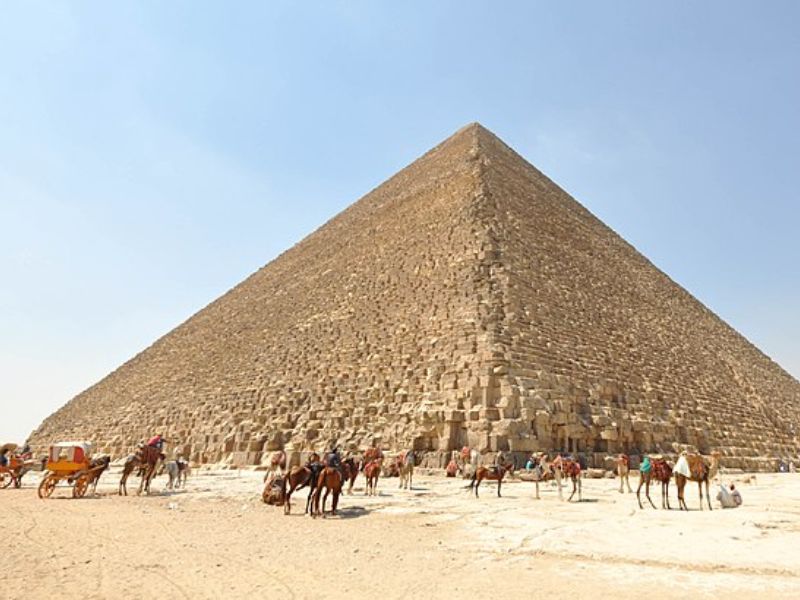
Source: Jorge Láscar / wikicommons
Another exciting aspect of the Khufu Pyramid that was previously overlooked was the underground passages, commonly referred to as “the pit.” The 18th century saw the removal of rubble blocking the descending passageway, revealing a Greek or Roman character on one of the tunnel ceilings. This seemingly confirmed the Greek historian Herodotus’s accounts that the pyramid’s interior was accessible during the ancient Roman Period.
Iconic Items Found In The Pyramid
Even with its grandeur, the artifacts found within the pyramid are limited. Only three items, known as the “Dixon Relics,” were discovered by Waynman Dixon in 1872. These include a heavy granite sphere, a forked copper instrument, and a wooden slat. The forked device is believed to have once had a bone or wooden handle and was probably used to manipulate rope, while the granite sphere served as a pounder.
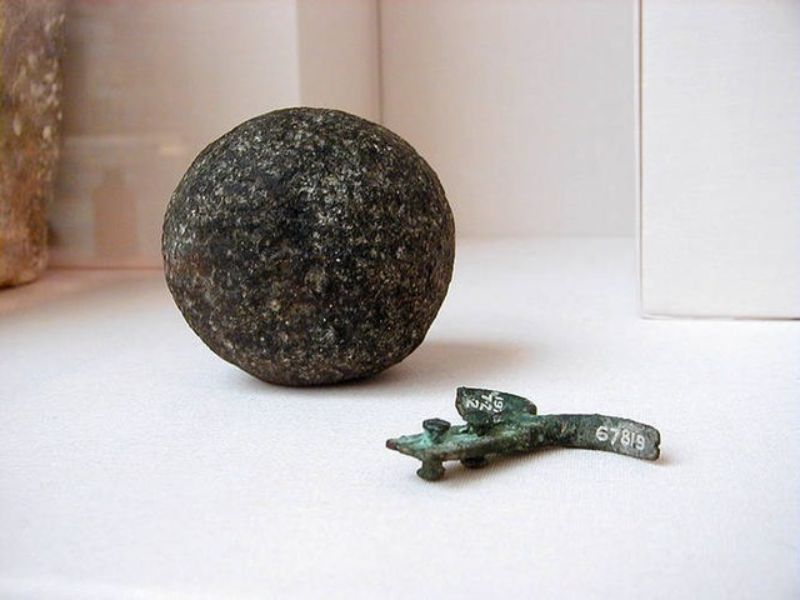
Source: Vincent Brown / wikicommons
The wooden slat had been missing for over a century but was rediscovered in 2020 by a curatorial assistant at the University of Aberdeen. Interestingly, the slat was carbon-dated to 500 years before the pyramid’s construction, raising new questions about when it was actually built.
The Meidum Pyramid, Meidum
Located about 62 miles from Cairo, the Meidum Pyramid was constructed during the reign of King Sneferu, the first ruler of the Fourth Dynasty (2613 to 2589 BC). It is said to be the first straight-sided pyramid of Egypt, sometimes referred to by some as a “sandcastle,” and is known as a “false pyramid.” The pyramid faced multiple construction challenges and was never finished, making it look distinct from other pyramids in Egypt.
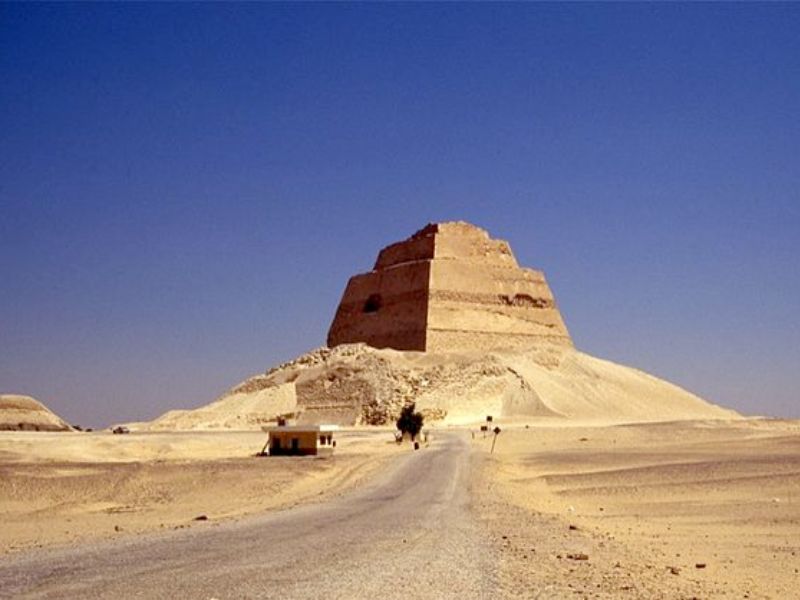
Source: Charlie Phillips / wikicommons
A steep passageway of 56 feet in length leads visitors to what would have been the burial chamber. Still, it was never completed, so there are no human remains, sarcophagus, or valley temple, which is a usual inclusion in ancient Egyptian royal burials.
A Wall Painting in the Meidum
The Meidum Geese painting was found in a tomb next to the Meidum Pyramid and is now on display at the Egyptian Museum of Cairo. The artwork showcases six geese, with two pairs facing away from each other in the center and one goose at each end, pecking at the grass. Even though the painting was created using a faster paint-and-plaster technique, the level of detail is still impressive. The pigments used include white from limestone, red from hematite, and green from malachite, all of which were mixed with egg white emulsifier.
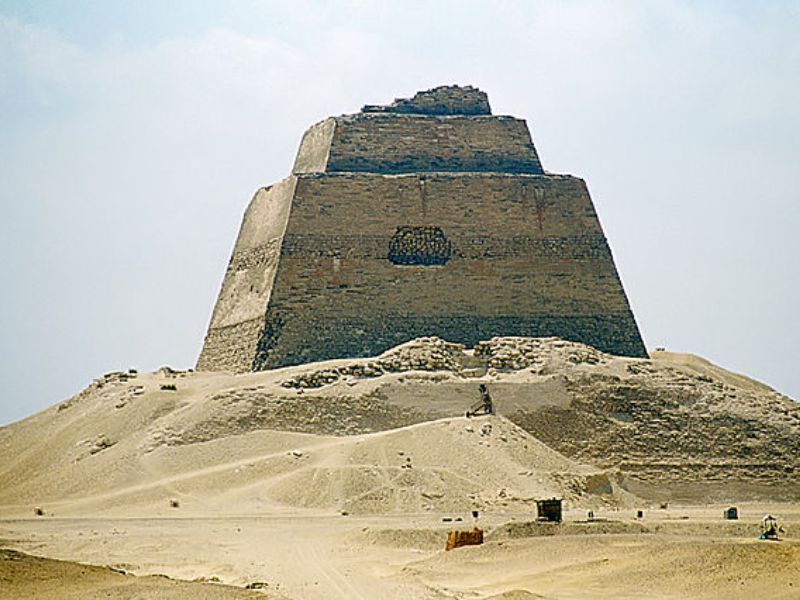
Source: Roland Unger / wikicommons
The painting was found on the north wall in the tomb chapel of Itet, who was the daughter-in-law of King Sneferu and the wife of his son Nefermaat and it was part of a larger scene in the tomb. While the original painting is on display at the Egyptian Museum of Cairo, there is also a replica of it on display at the Metropolitan Museum of Art in New York.
The Bent Pyramid
Dahshur is an ancient plateau located 20 miles south of Cairo, home to the Bent Pyramid, built by King Sneferu as a second pyramid, an addition to his straight-sided pyramid at Meidum. The pyramid’s shape is unusual due to construction issues, with the lower half at an angle of 54 degrees to 154 feet, then suddenly switching to 43 degrees.
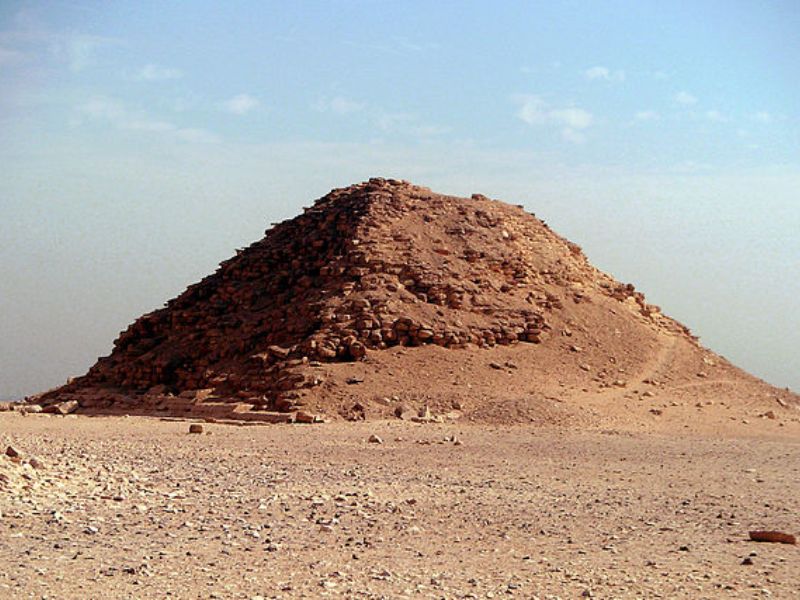
Source: JMCC1 / wikicommons
The interior of the Bent Pyramid was reopened to the public in 2019 after an extended closure for structural works. In 2021, Anyextee, an author and tour leader, discovered graffiti dating back to 1839, left by Egyptologist John Shae Perring, who explored the pyramid. Anyextee also found an interesting “Indiana Jones trap,” a stone gate that would have been lowered across the passageway to block the entrance.
The Mummies of Bent
In 2019, several mummies were found in and around the Bent Pyramid, most of which were well-preserved inside the stone, clay, and wooden coffins. The finds also included funerary masks dating back to the Late Period (664-332 BC), much later than the reign of Sneferu in the 25th century BC.
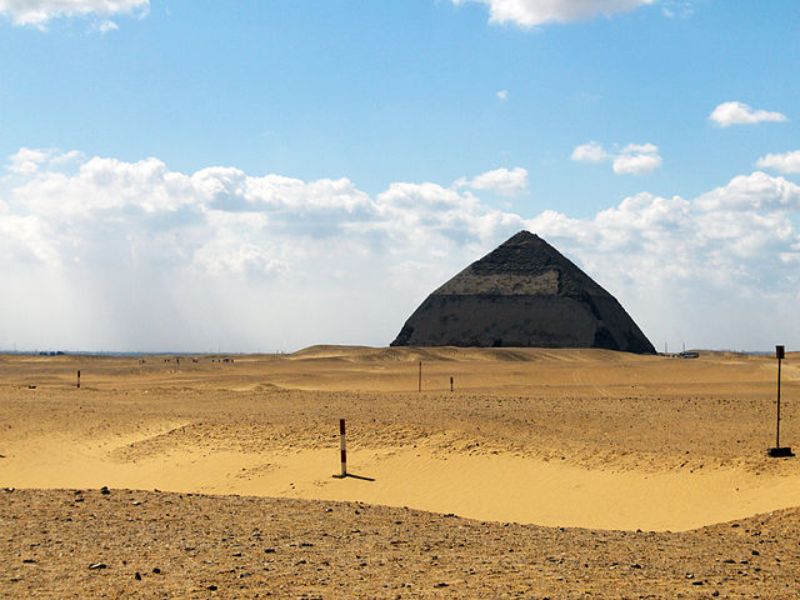
Source: Gary Ku / wikicommons
Along with the reopening of the pyramid, visitors can now also visit a smaller, adjoining pyramid believed to be the burial site of Queen Hetepheres I, Sneferu’s wife and Khufu’s mother. This pyramid has not been open to the public since its excavation in 1956. Excavations at the site are still ongoing, but visiting the Bent Pyramid offers a unique glimpse into the layout and differences among the pyramids.
Khafre Pyramid
Khafre Pyramid, the second largest in the Great Pyramids of Giza complex, was built by King Khafre (2558-2532 BC) next to his father’s Khufu pyramid, and it appears deceptively larger due to its higher location on the plateau. Built between 2520 and 2494 BC, only the top of the pyramid retains its original Tura limestone outer casing, while the rest has worn away, giving it a snow-capped mountain-like appearance.
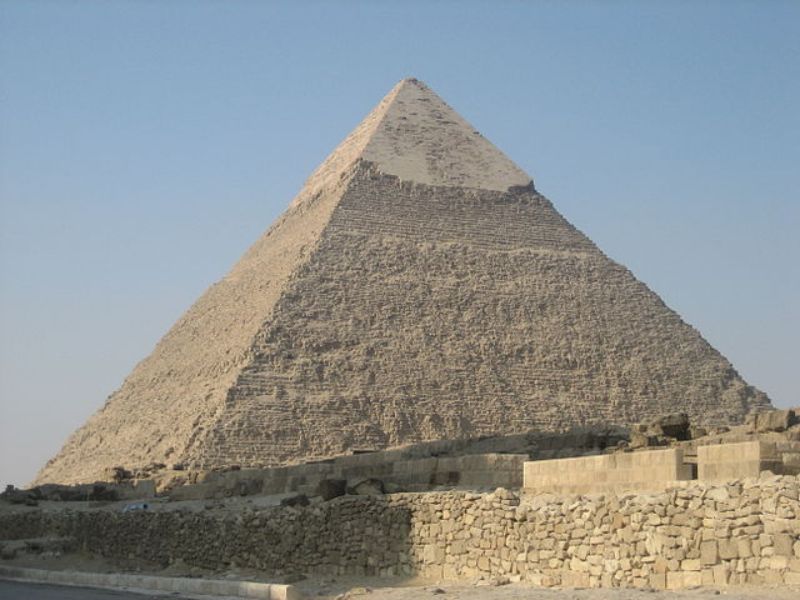
Source: Daaaveee / wikicommons
The Great Sphinx in front of the pyramid is also believed to have been built for Khafre. Statues found at the pyramid are now on display at the Egyptian Museum of Cairo, including the famous Khafre Enthroned, a funerary statue discovered in the valley temple, meant to provide a resting place for Khafre’s ka (soul). The figure depicts the pharaoh sitting on a throne with lion paws, hieroglyphics, a royal cobra, and the god Horus, symbolizing his power.
Tomb Raiders Hit The Khafre
Tomb raiders have repeatedly robbed the Khafre Pyramid over the years. Even Pharaoh Ramesses II is said to have taken sections of the pyramid’s limestone casing for his temple. With few artifacts remaining, historians have studied the pyramid’s construction materials.
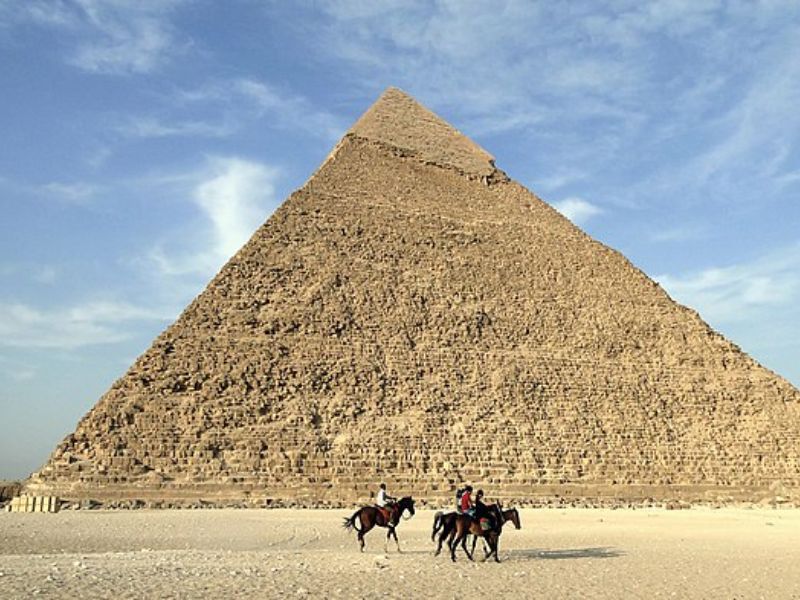
Source: Myousry6666 / wikicommons
The upper descending passageway was clad in granite, and gabled limestone beams supported the burial chamber. Even with the looting, the pyramid still offers an exciting glimpse into the techniques used in its construction.
The Strange Djoser Pyramid
The Djoser Pyramid, located in Saqqara in ancient Memphis, is possibly the most unique-looking in Egypt. Built by pharaoh Djoser (2650-2575 BC), who was the first to use stone in a pyramid’s construction, the bizarre tiered structure was designed by architect Imhotep by stacking mastabas to create a step pyramid, which is 204 feet high, and the first of its kind.
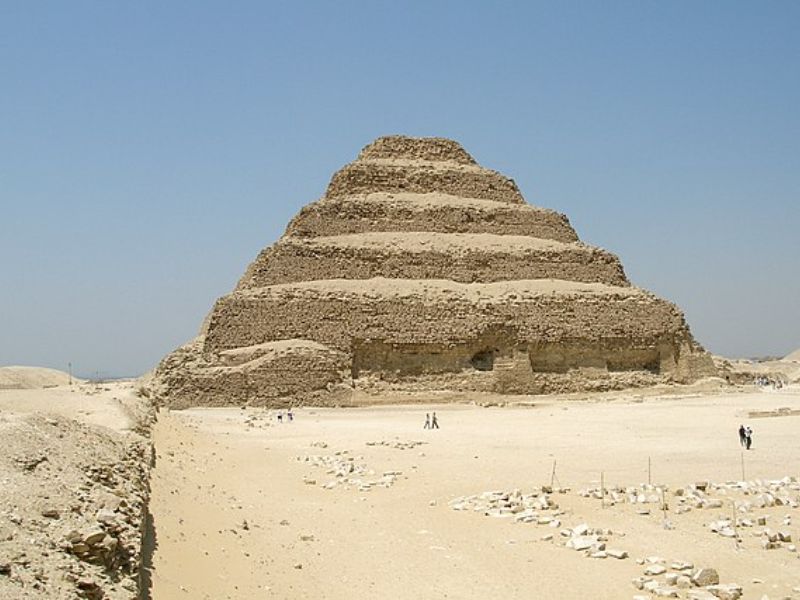
Source: Vyacheslav Argenberg / wikicommons
Inside the pyramid, Djoser’s sarcophagus and 40,000 stone vessels, bowls, and urns of various sizes were found, inscribed with the names of pharaohs from the First and Second Dynasties, which is curious as Djoser was one of the first kings of the Third Dynasty. The reason for this is still not completely understood, but it’s believed that the earlier pharaohs’ tombs were robbed, and Djoser collected their urns to protect their souls and sealed them inside his own tomb.
Unique Tiles In The Djoser
The pyramid galleries and burial chamber have recently revealed a series of stunning blue and green tiles, once used to imitate decorative reeds in the king’s palace. These tiles, created in the faience glazing style, symbolize rebirth and can be viewed at the Imhotep Museum in Saqqara and the Metropolitan Museum of Art in New York.
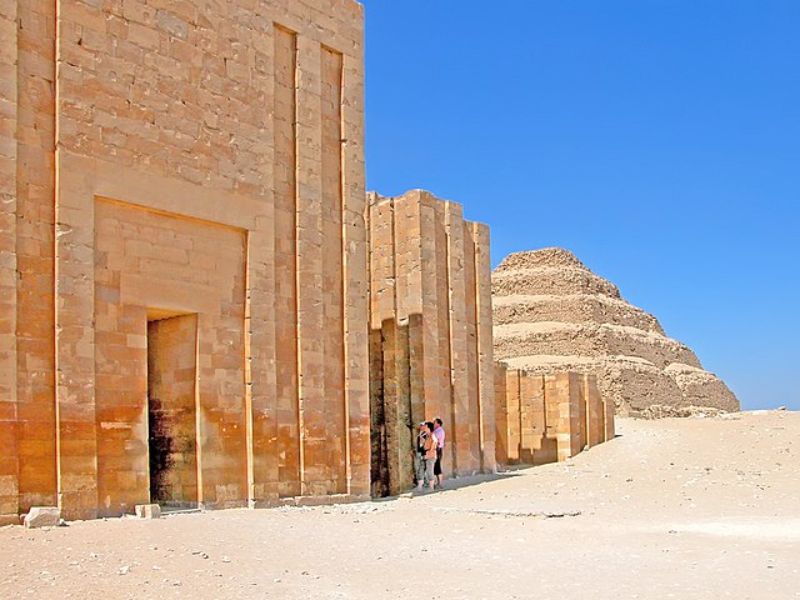
Source: Dennis Jarvis / wikicommons
In 2006, the pyramid underwent extensive restoration to prevent collapse, including reassembling and restoring the sarcophagus, adding paved floors and a lighting system, and strengthening the walls and ceilings. As a result, the pyramid finally reopened to the public in 2020, allowing visitors to experience one of Egypt’s most significant UNESCO World Heritage Sites.
The Red Pyramid
The Red Pyramid, located in Dahshur, is famous for its reddish hue, exposed after removing its limestone casing. The pyramid was built by pharaoh Sneferu, with its construction date debated but believed to be between 2575 and 2551 BC.
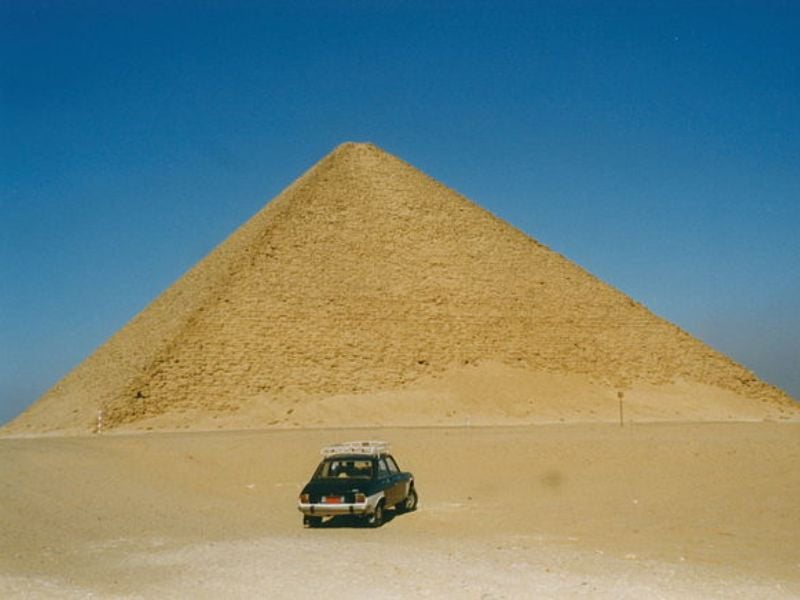
Source: Arian Zwegers / wikicommons
Often referred to as the North Pyramid, it’s the third largest in Egypt, after Khufu and Khafre pyramids in Giza. The Red Pyramid is considered the first true pyramid without steps, and visitors can explore its 4,000-year history by visiting its magnificent burial chamber.
The Red Pyramid is Uncharacteristically Sturdy
The Red Pyramid boasts unique passageways and chambers, featuring corbelled ceilings supporting its two million tonnes of stone. Unlike other pyramids, it has not suffered any structural issues or cracks.
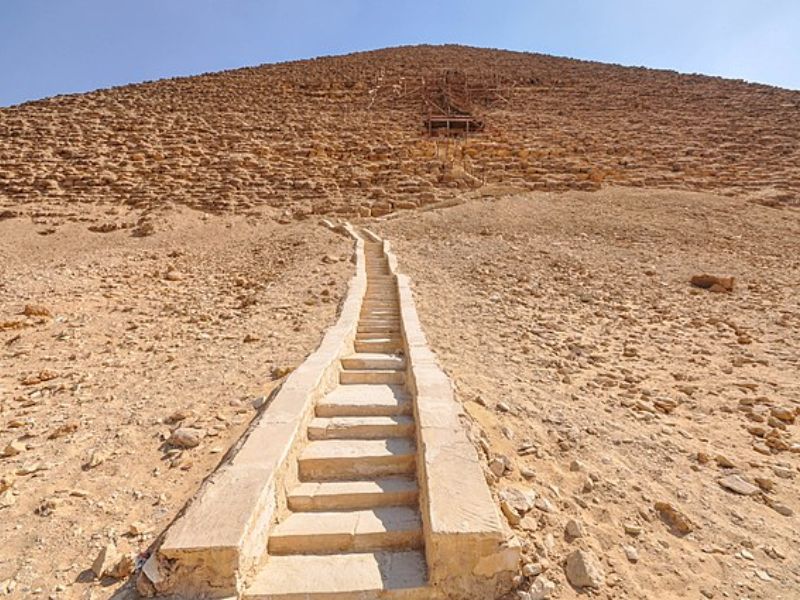
Source: Jorge Láscar / wikicommons
Notably, its second chamber is uniquely located directly beneath the pyramid’s apex, a design not seen in any other pyramid. The final section is accessible to visitors via a staircase, but other passageways have yet to be discovered. Even with age, the Red Pyramid has stood the test of time, remaining intact to this day.
The Menkaure Pyramid, Giza
The Menkaure Pyramid is the last and smallest of the three Great Pyramids of Giza, standing at 213 feet tall. Built for King Menkaure in the 26th century BC, it sits on the same plateau as the pyramids of his father and grandfather. Inside the tomb, many statues depict Menkaure accompanied by gods and figures, including a greywacke stone statue of Menkaure and his wife.
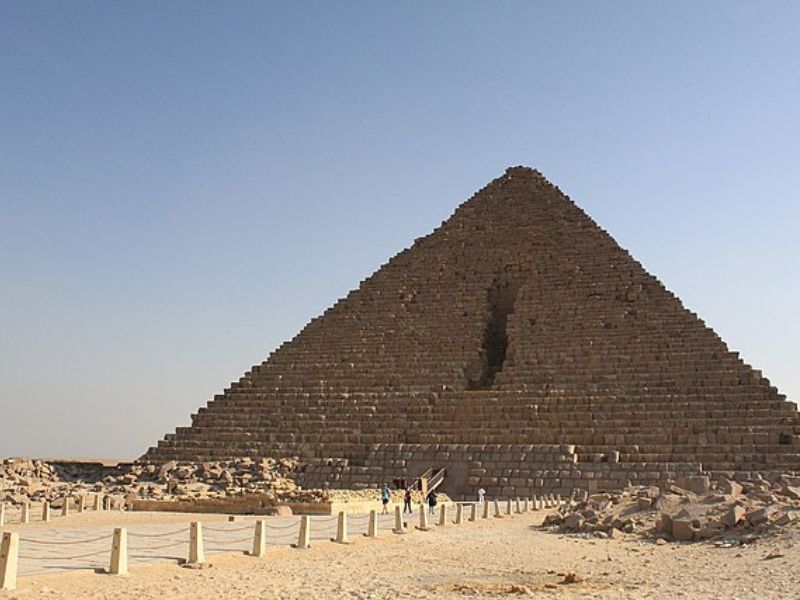
Source: Vincent Brown / wikicommons
This statue is a classic example of an Old Kingdom royal tomb sculpture, with the king’s arms down by his sides and one leg stepping forward. Regardless of its smaller size, Menkaure Pyramid is a fascinating example of ancient Egyptian architecture and history.
The Userkaf Pyramid, Saqqara
The Userkaf Pyramid, built by King Userkaf in 2494-2487 BC, the first pharaoh of the Fifth Dynasty, has an interesting history. Userkaf chose to build his pyramid at Saqqara, where the limestone is thinner than in other tomb locations like Giza. This, combined with poor structuring, led the pyramid to collapse, earning the nickname “Heap of Stone.”
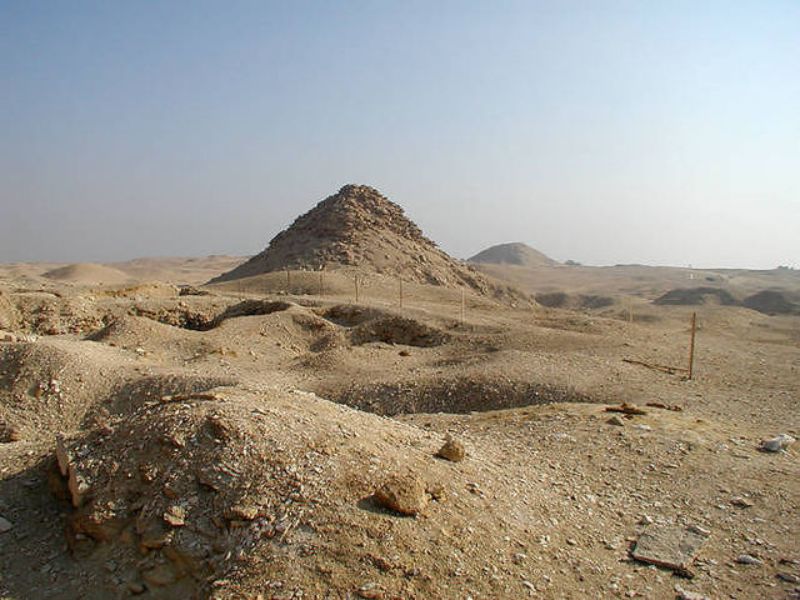
Source: Jon Bodsworth / wikicommons
Today, it resembles a conical hill more closely than a grand royal pyramid. Nonetheless, it still holds historical significance as the first pharaoh of the Fifth Dynasty attempted to build his tomb.
The Mysteries Of Userkaf
The Userkaf Pyramid, while mostly unexcavated, has yielded some interesting finds, including funerary stone reliefs from the king’s funerary temple. These reliefs, which would have once adorned the courtyard walls, depict hunting, fishing, and nature scenes typical in Fifth Dynasty royal temples. One limestone relief showcases birds in a papyrus thicket, two intricately carved birds in a marsh along the Nile, and names of Upper and Lower Egyptian derivatives connected to the cult of Userkaf, with the reliefs painted initially.

Source: Prof. Mortel / wikicommons
In 2018, tombs on the edge of the Userkaf Pyramid complex were discovered, containing sarcophagi and mummified cats, which were believed to hold special positions in the afterlife, as well as mummified scarab beetles, an unusual find for such tombs, which were thought to symbolize the sun god, Ra.
The Unas Pyramid
King Unas, who ruled during the Fifth Dynasty, built his pyramid at Saqqara, which once stood 141 feet tall. However, after his death, it fell into disrepair, and later Egyptian kings removed and reused most of its stones. Despite its state, an inscription by Prince Khaemwaset, the son of Ramesses II and High Priest of Ptah in Memphis, who restored the monument in the 13th century BC, can still be seen.
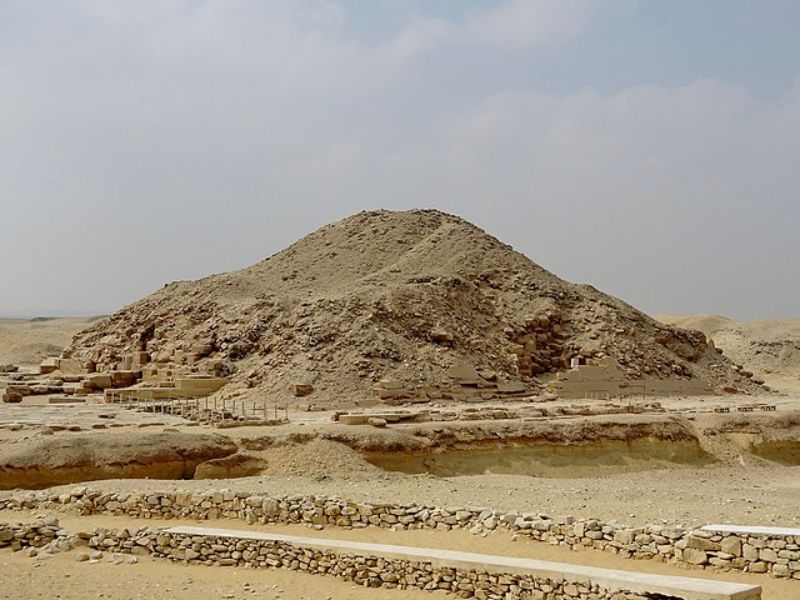
Source: Olaf Tausch / wikicommons
Additionally, funerary masks were placed over the faces of mummies to resemble the deceased and help the soul find its body in the afterlife. One such artifact believed to be Prince Khaemwaset’s funerary mask was found in the Serapeum of Saqqara, a burial place near Memphis.
It Was The First Of Its Kind
The Unas Pyramid was the first to feature “pyramid texts,” instructional spells on tomb walls to help the spirit navigate the underworld. The texts were never the same, but one frequently included was a spell discussing the sun god Ra. Inside the burial chamber, a sarcophagus was found, with a ceiling patterned with gold stars on a night-blue sky.
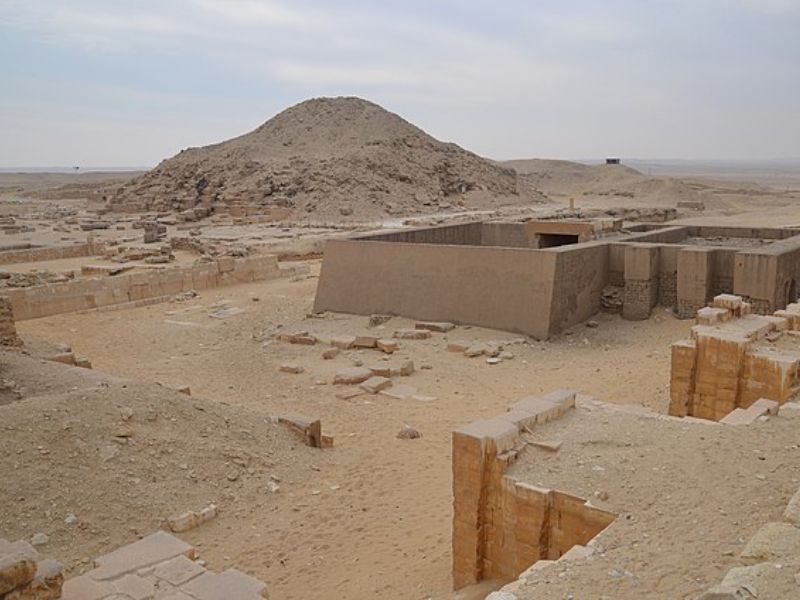
Source: Carole Raddato / wikicommons
Even though the contents were robbed, mummified remains of a left arm, hand, and skull were found among the debris. Also found at the Saqqara site was a thin gold band with red carnelian and volcanic glass beads forming angular patterns and hieroglyphics inscribed on the buckle, dating back to 2323-2150 BC.
The Teti Pyramid
Once 172 feet tall, the Teti Pyramid was built for King Teti, the first pharaoh of the Sixth Dynasty (2345-2323 BC). Located in Saqqara, it was constructed with a core of stone blocks encased in limestone and featured painted reliefs, star-patterned ceilings, and three niches that may have held statues of the king.
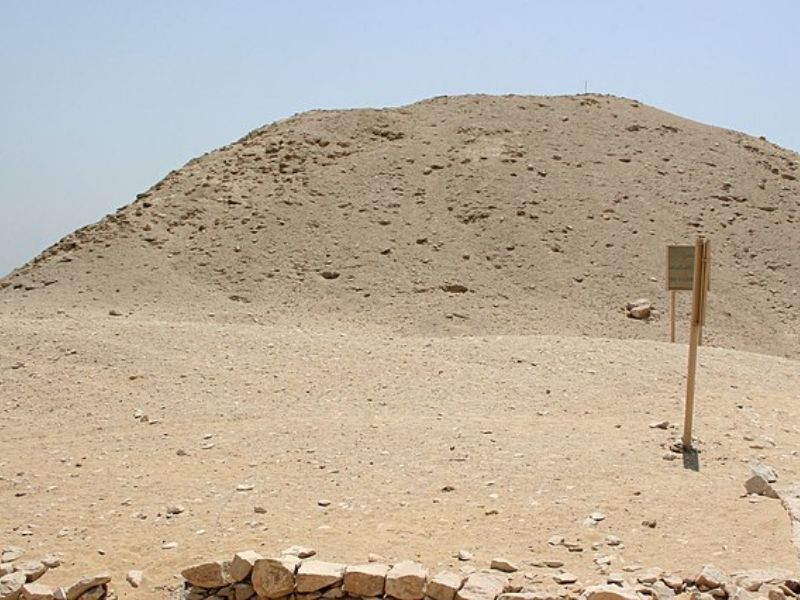
Source: kmf164 / wikicommons
Today, the pyramid is more of a lopsided mound, but tours are still possible. Regardless of the looting over the years, artifacts have been recovered, including a wooden comb believed to be from Teti’s tomb, on display at the MET Museum in New York. A cemetery containing the remains of Teti’s officials was also found in front of the pyramid.
Teti's Texts Influenced The Book of The Dead
Archaeologists recently discovered a buried chamber beneath the Teti Pyramid, filled with a well-preserved sarcophagus and pyramid texts. These texts were first seen in the Fifth Dynasty and later evolved into the Coffin Texts of the Middle Kingdom. Both influenced the New Kingdom’s Book of the Dead.
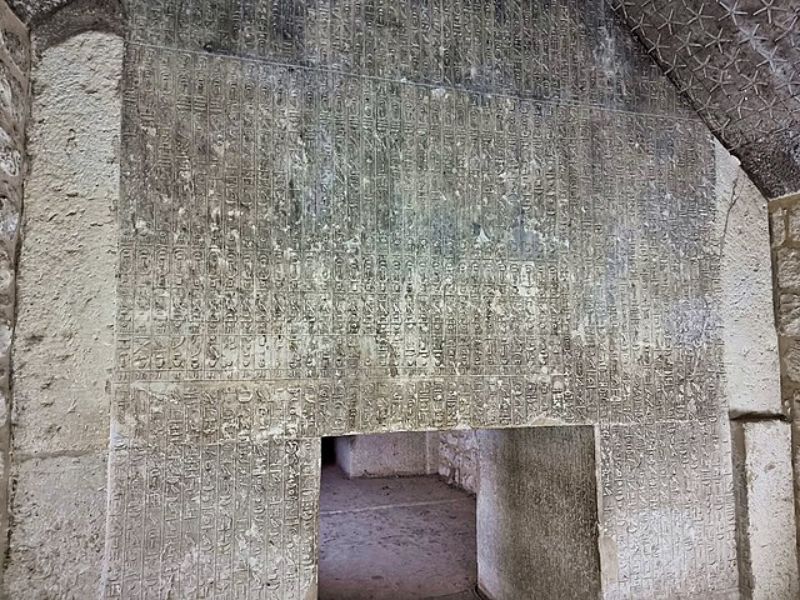
Source: Prof. Mortel / wikicommons
Further digging at the Saqqara site revealed hundreds of coffins and mummies from the New Kingdom, along with artifacts possibly belonging to Tutankhamun’s advisors. Among the findings were statues, shabtis, and ancient Egyptian games, set to be displayed at the Grand Egyptian Museum in 2023.
The Pyramid of Neith
Exciting news for Egyptologists, a previously unknown pyramid of an Egyptian queen named Neith was recently uncovered by archaeologists. The newly excavated site can be seen here, with the Teti and Djoser pyramids visible in the background.
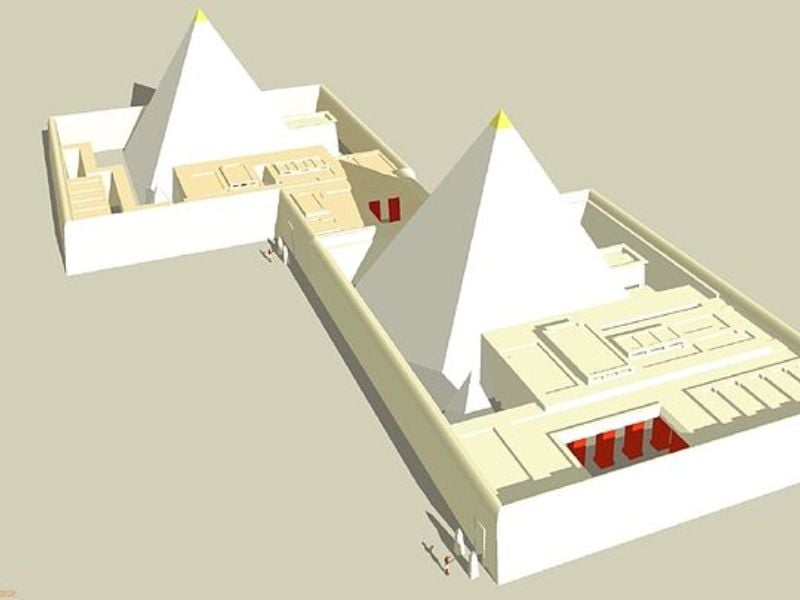
Source: Neithsabes / wikicommons
Neith was believed to be named after the goddess of creation, wisdom, weaving, and war, who was also worshiped as a funerary goddess.
The Valley of the Queens
A vibrant painting of Queen Nefertari was discovered in her tomb in Luxor’s Valley of the Queens. The queen, who was buried in a small rock-cut temple, is depicted playing senet, an ancient Egyptian game with deep symbolic meaning.
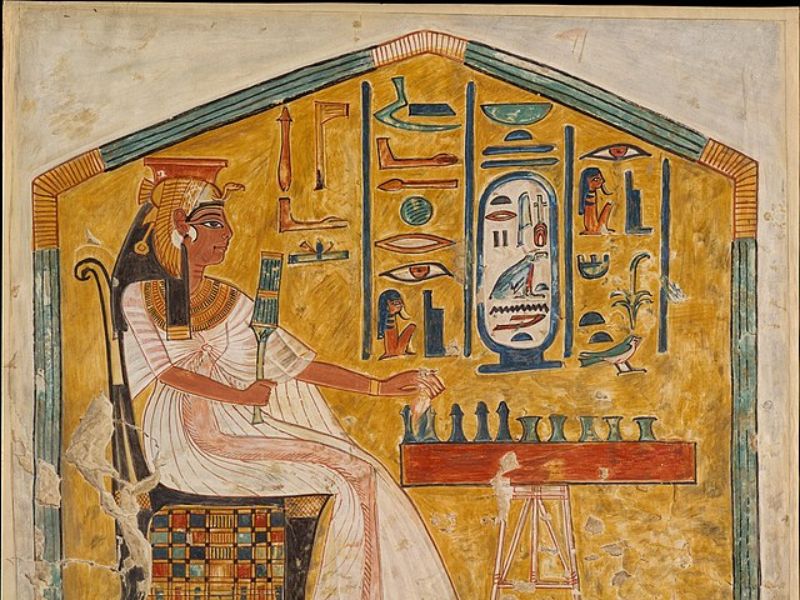
Source: Nina M. Davies / wikicommons
It was believed to parallel the journey into the afterlife, as the name senet means ‘passing.’ This painting provides a glimpse into the culture and beliefs of ancient Egypt.
The Famous Valley of the Kings
Tutankhamun’s tomb is world-famous, although it was not unearthed until 1922. His impressive funerary mask was crafted from 10kg of gold and adorned with lapis lazuli, quartz, glass, and obsidian. To assist his passage to the afterlife, his body was wrapped in resin-soaked bandages and surrounded by items.
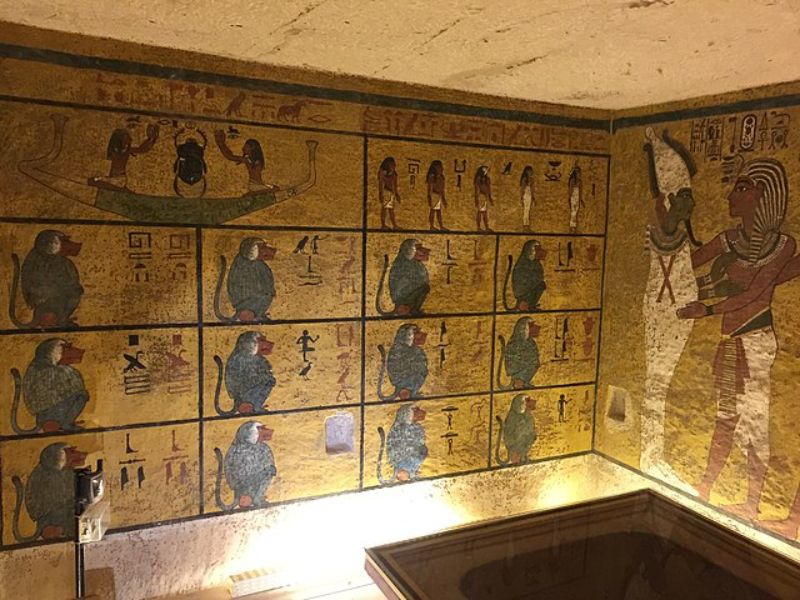
Source: EditorfromMars / wikicommons
For years, historians have pondered the question; could the tomb have been intended for his stepmother, Queen Nefertiti? Many believe it was reused for Tutankhamun.
Stunning Jewelry Found In The Valley of the Kings
Egyptians loved wearing jewelry, and many items were discovered in ancient tombs. The scarab bracelet from Tutankhamun’s tomb is a stunning example of craftsmanship made from gold and lapis lazuli. Apart from that, eighty pairs of sandals and toe stalls (golden toe coverings) were found in his tomb.
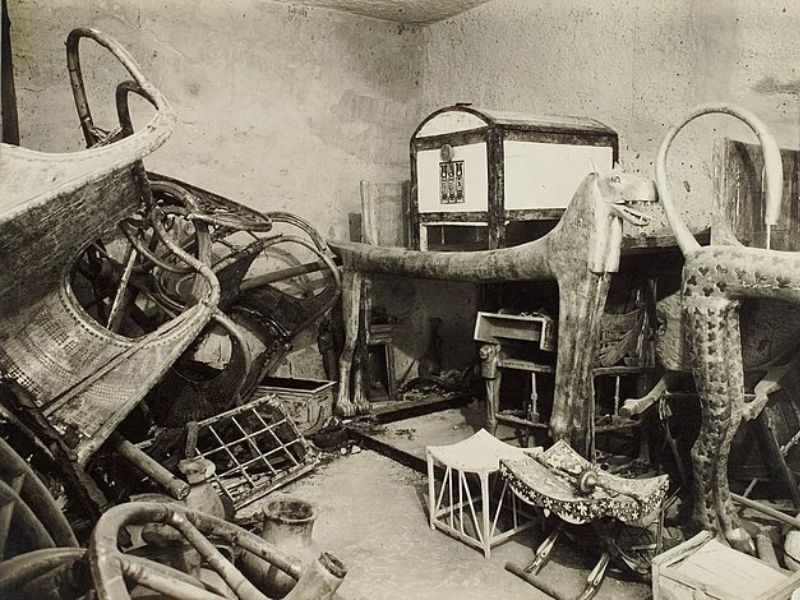
Source: Harry Burton / wikicommons
These items served symbolic purposes; each sole featured figures and arches representing Egypt’s nine traditional enemies, which the pharaoh symbolically quashed. In addition, these artifacts are a testament to the rich culture the Egyptians left behind.
The Royal necropolis of Tanis
In 1939, Pierre Montet, a French Egyptologist, unearthed a royal necropolis at Tanis that had remained untouched – an incredible feat, as no intact royal tombs had been found. He uncovered sarcophagi, silver coffins, and vast amounts of gold and silver.
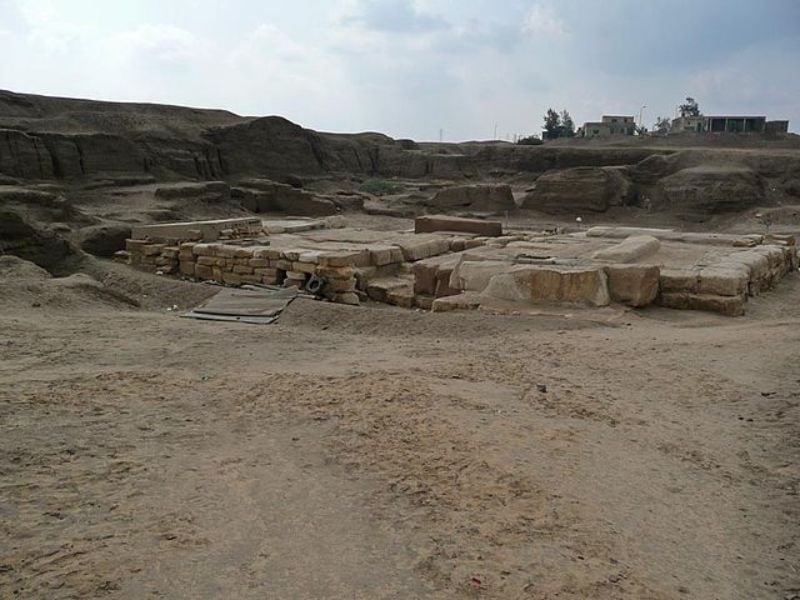
Source: Jon Bodsworth / wikicommons
This astonishing find rivaled Howard Carter’s Tutankhamun discovery, and the most famous of the Tanis Treasures was Shoshenq II’s silver coffin. The 22nd Dynasty pharaoh wasn’t known until Montet’s discovery, and the coffin featured a falcon instead of the king’s head. Unlike the usual canopic jars, the coffin also contained miniatures of the pharaoh’s organs.
More Stunning Artifacts Found in the Necropolis
Found in Shoshenq II’s tomb, a breastplate-like collar remains a vivid reminder of ancient opulence. Shaped like a falcon, it depicts Nekhbet, a goddess commonly expressed as a vulture hovering above kings with a shen, symbolizing eternity.
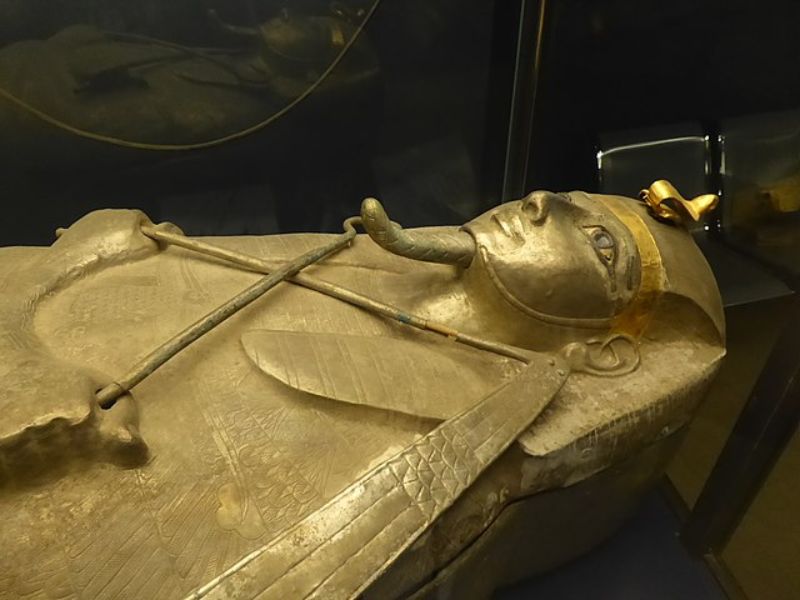
Source: Aidan McRae Thomson / wikicommons
Also found in Psusennes I’s tomb was a beaded necklace made of lapis lazuli and two golden beads dating back to roughly 1069-945 BC. Surprisingly, one bore an Assyrian inscription, prompting speculation as to why it was in an Egyptian king’s tomb.
The Necropolis Also Held An Army General's Tomb
Wendjebauendjed was a key figure during King Psusennes I’s reign, evident by his tomb in the royal cemetery. His funerary mask features a slight smile and glass-inlaid eyes, but the left ear is longer than the right.
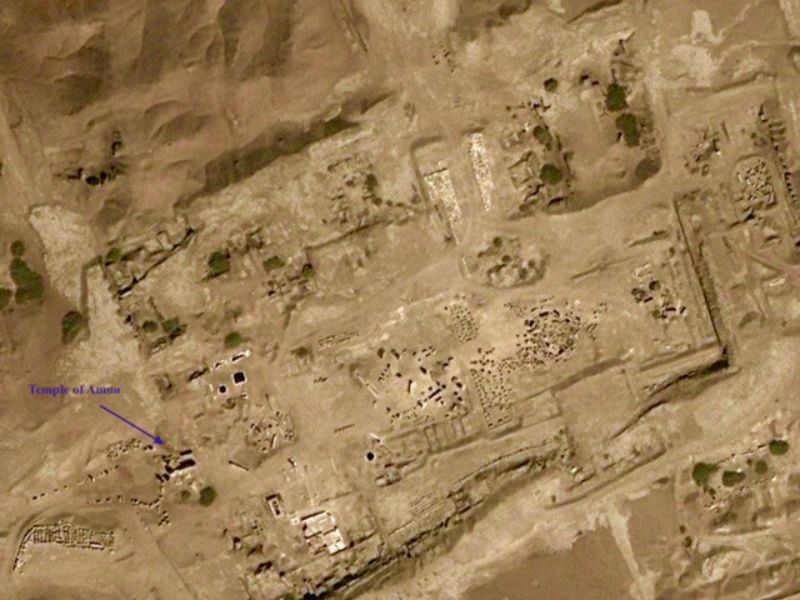
Source: Zemanst / wikicommons
A stunning pectoral brooch was also discovered, with a lapis lazuli scarab at its center and flanked by goddesses Isis and Nephthys, who protected the person wearing it. Finally, the bottom has a cartouche with the king’s name, symbolizing rebirth.
